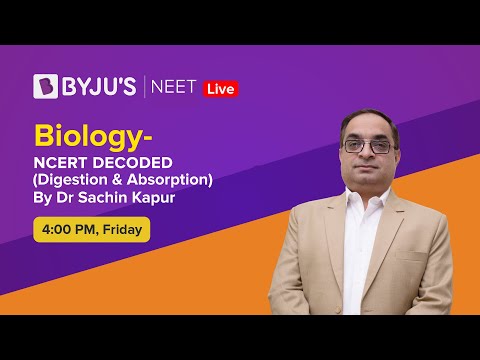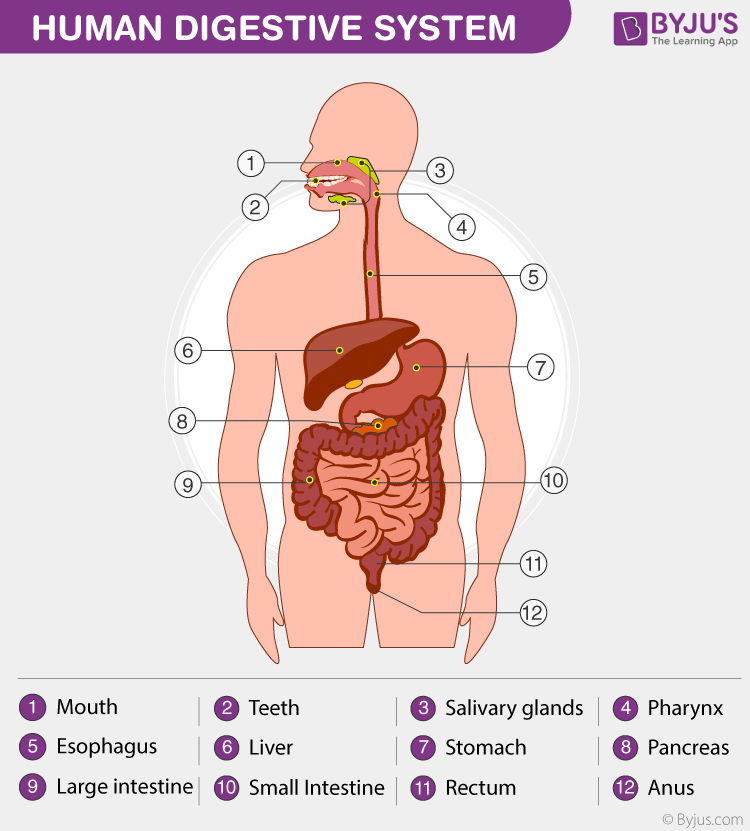Find below the important notes for the chapter, Digestion and Absorption, as per the NEET Biology syllabus. This is helpful for aspirants of NEET and other exams during last-minute revision. Important notes for NEET Biology- Digestion and Absorption covers all the important topics and concepts useful for the exam. Check BYJU’S for the full set of important notes and study material for NEET Biology and solve the NEET Biology MCQs to check your understanding.
Download Complete Chapter Notes of Digestion and Absorption
Download Now


| Name of the NEET sub-section | Topic | Notes helpful for |
| Biology | Digestion and Absorption | NEET exams |
Digestion and Absorption – Important Points, Summary, Revision, Highlights
Table of Contents
Digestion and Absorption
Digestion is the process of breaking down complex food particles into simpler forms to absorb nutrients.
The digestive system of humans comprises an alimentary canal. There are various glands associated with it.
Don’t miss: NEET 2022 Answer Key PDF
Structure of the Alimentary canal

The alimentary canal has the following parts:
- Mouth: Teeth have thecodont attachment, i.e. embedded in a jaw bone socket.
- Diphyodont: Two sets of teeth during a lifetime. The deciduous or milk teeth (20) are replaced by permanent adult teeth (32)
- Heterodont: There are four different types of teeth. Incisors (8, for biting), Canines (4, for tearing), Premolars (8, for crushing and grinding), molars (12, for making smaller pieces)
- The dental formula is 2123/2123, it represents the upper and lower half of the jaw
- Taste buds are present on the upper surface of the tongue in papillae
- The tongue is attached to the oral cavity by the frenulum
- Pharynx: Gives passage to food and air. The epiglottis (a cartilaginous flap) blocks the entry of food into glottis, the opening of trachea (windpipe)
- Oesophagus: It is a long tube that opens into the stomach, which is regulated by a muscular gastro-oesophageal sphincter
- Stomach: It is divided into four parts:
- Cardiac – where oesophagus opens
- Fundic
- Body- central region
- Pyloric- opens in the small intestine
- Small Intestine: It is the longest part of the alimentary canal. Pyloric sphincter connects the stomach to the small intestine. It has three parts:
- Duodenum
- Jejunum
- Ileum
- Large Intestine: It also has three parts:
- Caecum- it is a blind sac, which hosts microbes and has vermiform appendix (a vestigial organ) attached to it
- Colon- it consists of four parts; ascending, transverse, sigmoid and descending
- Rectum- opens out of the body through the anus
Further reading: Pharynx Location
Histology of Human Alimentary Canal

From oesophagus to rectum there are four layers present in the wall of the alimentary canal:
- Serosa is the outermost layer, which is made up of mesothelium and connective tissues.
- Muscularis is made up of smooth muscles, outer longitudinal and inner circular.
- Submucosa is made up of loose connective tissues and contains lymph, blood and nerves. It contains glands in the duodenum part.
- Mucosa is the innermost layer and contains irregular folds and gastric glands in the stomach area. Villi and microvilli and crypts of Lieberkuhn are present in the small intestine, which greatly increase the surface area of absorption. Mucus is secreted from the goblets cells of mucosal epithelium, which helps in lubrication.
Digestive Glands
Salivary glands: Saliva is secreted into the buccal cavity by three pairs of the gland; parotid- cheek, submaxillary or sub-mandibular- lower jaw and sublingual- below the tongue.
Liver: It is the largest gland (1.5 – 2 kg), present below the diaphragm. There are two lobes present in the liver. The hepatic cells secrete bile juice, which is stored in the gallbladder. Hepatic lobules contain hepatic cells and are the structural and functional unit of the liver. Hepatic lobules are covered by Glisson’s capsule (a sheath of connective tissue).
The bile duct is formed from the cystic duct (coming from the gallbladder) and hepatic duct (from the liver).
Pancreas: It performs exocrine (enzymes) as well as endocrine (hormones insulin and glucagon) function. The pancreatic juice is alkaline.
Sphincter of Oddi is present at the opening of the hepato-pancreatic duct (bile duct + pancreatic duct) into the duodenum.
Digestion of Food
The digestion of food starts from the mouth itself. The masticated food mixed with saliva makes a small mass of food called a bolus. The bolus moves to pharynx and oesophagus by the process of deglutition (swallowing). There are various enzymes that get mixed with the food at different parts of the alimentary canal and facilitate digestion.
| S.No. | Part of the Alimentary canal | Secretion | Enzymes | Action |
| 1. | Mouth | Salivary glands- Saliva | Lysozyme | Antimicrobial |
| Amylase | Hydrolysis of carbohydrates (pH-6.8)
Starch → Maltose |
|||
| 2. | Stomach | Mucous neck cells | Mucus | Lubrication and protects from excoriation by HCl |
| Peptic cells (chief) | Pepsinogen, a proenzyme converts to Pepsin in the presence of HCl
Rennin in infants |
Proteolytic enzyme (Protease)
Protein → proteoses + Peptones (pH-1.8) Digests milk proteins |
||
| Oxyntic cells (parietal) | HCl
Intrinsic factor |
HCl makes the pH acidic for the action of pepsin
Intrinsic factor is required for the absorption of vitamin B12 |
||
| 3. | Duodenum of Small Intestine | Pancreatic juice | Mucus with bicarbonates | Maintains alkaline pH (7.8) and protects intestinal mucosa from HCl |
| Trypsinogen → trypsin by enterokinase | Proteins, Peptones and proteoses, converted to dipeptides | |||
| Chymotrypsinogen | ||||
| Procarboxypeptidase | ||||
| Amylases | Polysaccharides into disaccharides | |||
| Lipases | Fats to di and monoglycerides | |||
| Nucleases | Nucleic acids to nucleotides and nucleosides | |||
| Bile | Bile pigments, bile salts, cholesterol and phospholipids
No enzymes |
Emulsification of fat into micelles and activates lipases | ||
| Succus entericus (Intestinal juice) | Disaccharidases (maltase) | Maltose to Glucose | ||
| Dipeptidases | Dipeptides to amino acids | |||
| Lipases | Di and monoglycerides to fatty acids and glycerol | |||
| Nucleosidases | Nucleotides to nucleosides to sugar + bases |
Don’t miss: Important NEET Chemistry questions and answers
Absorption
The bio-macromolecules are broken down in the duodenum part of the intestine and get absorbed in jejunum and ileum. The undigested food moves to the large intestine, where some water and minerals get absorbed.
The absorption of food occurs by the process of diffusion due to concentration gradient or by facilitated transport by a carrier protein.
Water is transported by the osmotic gradient.
Amino acids, glucose, monosaccharides, Na+ are absorbed in the blood by active transport against the gradient and it requires energy.
Micelles form chylomicrons (protein-coated fat globules), which are transported into lacteals (lymph vessels) in the villi and released in the bloodstream.

Some amount of absorption takes place in different parts and maximum absorption takes place in the small intestine.
Mouth- drugs
Stomach- water, simple sugars and alcohol
Small intestine- maximum absorption
Large intestine- water and some minerals
By assimilation, the absorbed nutrient reaches the different parts of the body through bloodstream and lymph for utilisation.
Disorders of the Digestive System
Many bacterial, protozoan, parasitic and viral infections cause inflammation of the intestine. Some of the common disorders are jaundice, vomiting, diarrhoea, constipation, indigestion, etc.
The diseases due to malnutrition are very common in developing and underdeveloped countries.
Protein Energy Malnutrition (PEM) causes Marasmus and Kwashiorkor in infants and children.
Marasmus- It is due to a deficiency of protein and calories intake. The condition is characterised by thinning of limbs, extreme emaciation, dry and wrinkled skin and mental impairment.
Kwashiorkor- It is due to a deficiency of protein. There is wasting of muscles, but some fat is still present under the skin. The condition is characterised by swelling and extensive edema of body parts.
Explore the next chapter for important points with regards to NEET, only at BYJU’S. Check the NEET Study Material for all the important concepts and related topics.
Recommended Video:

Also Check:
NEET Flashcards: Digestion And Absorption
NEET Flashcards: Breathing And Exchange Of Gases
NEET Flashcards: Body Fluids And Circulation
NEET Flashcards: Excretory Products And Their Elimination
NEET Flashcards: Locomotion And Movement
Related Articles:
| Lipase Enzyme |
| Protease Enzyme |
| Pharynx Location |
| Hormonal Control Digestion MCQs |
notes are good completely based on ncert
It will helpful to us 👍👍👍 notes are good
it is very helpful
Notes are very helpful
They helped me to score more marks
good note but to download
good note